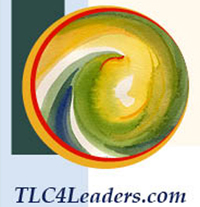Programs for Organizations
Programs highlighted here are a representative selection of those I have designed and led. Whether originally delivered as a public program or for a particular client, all can be adapted for groups within an organization.
All programs are updated and customized to meet your needs.
To explore what program might be timely for you, please contact me.
All programs are updated and customized to meet your needs.
To explore what program might be timely for you, please contact me.

Transformational Leadership Circles blend individual and group coaching with peer mentorship for a unique and uplifting professional development experience. We grapple with tough issues and get to the heart of what capable leaders struggle with. Highly accomplished professionals create safe haven together for curiosity, practice and insight. You grow in effectiveness, creative resourcefulness and wellbeing as leaders.
TLC for Leaders™ began as a dynamic outgrowth of my 2003 study, The Feminine Face of Leadership in Science. Study participants requested them!
Some TLC circles are for women only; some are for women and men.
You share questions, insights and creative solutions about challenges you face as leaders, often in relative isolation. Together you become "positive deviants" - people thriving where others struggle. You receive ideas, practices and relational support that you can use to transform your experience of leading.
In small-group coaching sessions, you
- Focus on current, actual challenges that you face as a leader,
- Engage in experiential exercises that reveal aspects of your physical, emotional and mental ways of being in leadership,
- Reinforce experiential learning with relevant literature exploring frontiers in leadership and, particularly, leading truer to yourself as a whole person,
- Participate as a "Peer Mentor" with leaders who can relate to your concerns and respect your perspective gained from experience,
- Learn skills and receive feedback and professional coaching that you can apply immediately to be more effective and satisfied.
"Peer Mentoring" takes place throughout. During and between sessions you learn with and from your peers - similarly situated leaders. Whether your peers are at "your level" and from your organization or outside your organizational and subject-matter focus, the exchange is rich.
"Peer Mentoring" is a different kind of mentoring, one that rarely happens beyond certain levels of accomplishment. Significantly, research shows this is especially true for women. It is invaluable for leaders at higher organizational levels and in situations where peer interaction tends to be more competitive than cooperative.
Circles symbolize wholeness and the experience of unity. TLC for Leaders™ provides the kind of transformational growth that thoughtful, high-performing leaders seek.
Contact me about offering a circle where you are.

What becomes possible when you can co-create better outcomes in tough situations? Are you ready to go there?
Critical, difficult conversations are the norm when you lead at the cutting edge. Communication and conflict management consistently rank among the top three critical “gaps” for leaders, regardless of level or industry. Coaching accomplished professionals and business leaders for nearly 20 years, I consistently hear what “burns” leaders up and burns them out. They want cultures where they innovate and co-create on purpose, NOT caught up in …
- “I’m stopped from making the impact that matters to me.”
- “I feel like I’m constantly one down in the power games here.”
- “So much of my time and energy goes to putting out fires that it’s hard to get the ‘real’ stuff done.”
- “People on our team have become so guarded and defensive that it’s hard to connect.”
What happens when people disagree with each other where you are? Do you notice signs of anger, frustration, avoidance or intimidation? Someone wants to be “right” but the “fight for right” - too often experienced as defensive, domineering or toxic communication - is surprisingly costly for high-performance leadership and collaboration. Rather than openly collaborating to fulfill strategic objectives, well-intentioned and capable people isolate and duck “under the radar” to protect their own survival.
Your conversations build your leadership and your culture. How creative can you be in an environment where conversations produce disengagement, exhaustion, discouragement, and waste? What can be better than this?
Transform Conversations for Creative Engagement
Conversational Alchemy™ gets to the heart of persistent challenges with openness, transparency and trust. Disarm the “wars of words.” Pull the plug on “overwhelm.” Activate your best. Create better outcomes.
See full description here. Call today for details and to start.

You are navigating an essential transition as a leadership team. Clearly, trust exists in your leadership and on your team. You’d be utterly dysfunctional if it didn’t. Continuing to function at the current levels – without changes – is possible and has very real costs. Choose a trust upgrade for better results and greater wellbeing.
- What changes when you upgrade trust?
- What difference does that make for you (or …why do you care)?
The emphasis on trust and betrayal dynamics is in recognition not only of immediate group needs but also in recognition of the nature of collaborative endeavor. A team choosing to grow becomes aware of painful gaps between what you experience, what you actually want and what you believe you’re capable of. To change the fruits, you have to get to the roots.
Trust is the “soft” foundation for what’s measured in “hard” business terms. It’s like connective tissue in the body; it has to be healthy everywhere for the other stuff to function optimally. There will forever be new versions of this software as individuals and teams evolve in awareness, skill and commitments for working together.
A meaningful upgrade requires using a common language, framework, standards and practices for your own leadership going forward. You step into a timely opportunity to heal, identify needs for improvement, and take individual and collective responsibility for constructive change.
Upgrading Trust for Real Team Change™ blends group learning with individual development and integration. It guides you to higher levels of sustainable high performance and wellbeing by addressing core trust dynamics. You’ll gain awareness and tools for dealing with recurrent, costly breakdowns that result in:
- Missed opportunities and slow recovery from mistakes
- Knowledge and participation withheld by workgroup members
- Coordination and communication breakdowns
- Toxic work environments, and
- Overall diminished productivity.
The blend of group and individual coaching is key. You’re installing new software, if you like. You have to work out how to “run” the software more effectively with the elements of your upgrade, with continuous awareness for individual and collective “bugs” and further “upgrades." Well-intentioned, capable people can get very cynical about “flavor of the month” and patterns that resist change, no matter what “how to-s” you present. Knowing what to do is necessary but insufficient.
The possibility of real change becomes realistic when you courageously take responsibility for making the shifts you need. As individual leaders, you have to consider how you use your power (internal and external) to influence those with whom you work. It takes emotional stamina and clear direction. That’s a significant aspect of your upgrade. Once you’ve upgraded, you’ll never look back.

Resilient and Resonant Leadership. How can you optimize creativity and collaboration when people experience anxiety, interact defensively, and suffer the effects of "power stress?"
Resilient, adaptive organizations are made up of resonant leaders choosing to bring out their best under pressure.
Integrating core practices from mindfulness and somatic disciplines, this 3-part program focuses on
- Self
- Conflict and
- Collaboration.
Participants expand their capacity to navigate difficulty and complexity, increase resilience and resonance, and create an environment that promotes long-term well-being and creative engagement.

What inner resources do you need to meet the demands and complexities of
leadership in times of transition?
Explore embodied skills and practices that allow you to navigate uncertainty and change with greater ease, trust and personal power.
- Develop a strong and open presence that clearly communicates your leadership and value.
- Trust yourself to make better decisions and move into action with greater confidence.
- Expand your capacity to have courageous conversations with others for the sake of building a more positive future together.

The challenge:
- How do you accelerate the speed at which you innovate in a collaborative environment characterized by increasing complexity, resource constraints and rapid change?
- What resources can you draw upon when people may already feel stretched to their perceived limits?
- In a work group where each individual contributor performs at high levels of excellence, how do you optimize the value and impact of your collaborative efforts?
The challenge is to cultivate collaborative excellence. This requires more than technical brilliance; it takes practice and skill in building relationships. As management theorist Karl Weick comments, “complex situations put a real premium on group processes, division of labor, trust, reaffirmation of what we respect and what we question in each other.” Trust is the crucial and most frequently overlooked element where groups strive for high-speed, high-performance collaboration. It is essential for relationship building that allows organizations to be agile.
Meeting the Challenge™ provides structure and focus for in-tact work groups to understand their specific collaborative dynamics, clarify where collaborative breakdowns occur, and create an environment together for breakthrough. Participants zero in on trust—what builds it, what restores it when it is betrayed—from their own experience and within the framework of the Reina Trust and Betrayal Model™.
To prepare, participants complete a brief online survey (Reina Team Trust Scale™). Based on their experiential and pragmatic inquiry in the program, group members identify objectives for what they want to reinforce or change and viable ways for accomplishing those objectives.

Are trust breakdowns affecting your team's morale, performance and satisfaction?
Leadership is both a role and a way of being in relationship with oneself and others. Trust is the fundamental ground of that relationship. A team that can reliably build and restore trust creates better results and a better place to work.
Trust in Leadership offers participants a framework by which to understand, experience, and talk about trust dynamics that are essential for productive, sustainable business relationships. Groups wishing to improve their performance and to facilitate easier, less fractious (or toxic) and more productive collaboration benefit greatly from the typically rare opportunity to explore honestly how they can best work together and what trust and betrayal dynamics they are experiencing and need to adjust.
This 2-day program combines models from the Reina Trust & Betrayal Model with a highly interactive and client-focused curriculum. In a short time, your team acquires new language, common understanding and experience for leading more effectively from a core of trust.

The level and consistency of collective effectiverness of the leadership system makes the difference between organizations that perform optimally and those that do not. It is not merely individual leadership effectiveness that results in high organizational performance. … Individual leadership effectiveness catalyzes collective effectiveness. Collective effectiveness carries the day. The organization cannot perform at a level higher than teh collective effectiveness of its leadership.
Mastering Leadership: An Integrated Framework for Breakthrough Performance and Extraordinary Results , by Robert J. Anderson & William A. Adams
[T]he most effective and fastest business organizations are those which understand how to mobilize the power of trust-based relationships in the workplace; it is a matter of focus, awareness and systems of structure and reinforcement. …How we create speed distinguishes the winners.
Building Trust at the Speed of Change, by Edward M. Marshall
Collaborative relationships are valuable to an organization not only because they produce better processes and better results, but also because they increase the amount of discretionary emotional energy that employees will devote to the organizational effort. Discretionary emotional energy is a term … to describe the passion, excitement, enthusiasm, and dedication that individuals choose to give freely to those causes, projects, relationships, and organizations in which they truly believe. Discretionary emotional energy cannot be mandated, and attempts to do so will inevitably lead to either outright rebellion or passive-aggressive undermining behavior. It is personal buy-in that can’t be bought.
Radical Collaboration: Five Essential Skills to Overcome Defensiveness and Build Successful Relationships, by James W. Tamm & Ronald J. Luyet

There is indeed ample evidence that under some circumstances, ...we can as individual people or in groups adopt a more growth-oriented stance, neither denying nor tuning out the confusing and overwhelming complexity. Instead we can sit with it, engage with it, develop and grow through it. In some situations, when conditions are right, we can transcend the apparent chaos and expand into something genuinely new. We adapt to the times, allowing the new circumstances to call forth capacities we did not know we possessed.
Dancing at the Edge: Competence, Culture and Organization in the 21st Century, by Maureen O'Hara and Graham Leicester
Myth: Conflict is negative. Nature doesn’t see conflict as negative. Nature uses conflict as a motivator for change. … As we begin to embrace conflict as a prime motivator for change in our lives, we begin to see it as an opportunity. We are able to use it effectively for nurturing growth in ourselves and in our relationships.
The Magic of Conflict. by Thomas Crum
Lead. Collaborate. Grow. ... to Thrive!

